MBA621 Healthcare Systems: Critical Analysis of NDMBS Program
VerifiedAdded on 2023/06/08
|14
|3364
|403
Report
AI Summary
This report provides an in-depth analysis of the New Directions Mothers and Babies Service (NDMBS), a specialized healthcare program designed to improve the health and well-being of Aboriginal and Torres Strait Islander women and children. The report evaluates the program's goals, needs, activities, and resources, highlighting its focus on improving access to antenatal care, providing practical information on parenting and baby care, and addressing the gap in mortality rates between indigenous and non-indigenous children. The analysis includes a discussion of ethical considerations such as beneficence, non-maleficence, justice, and respect, as well as an examination of risk identification and management strategies, particularly concerning cultural and language barriers. The report also assesses the program's quality and safety measures, noting its limitations in addressing racism as a determinant of health. The report concludes by emphasizing the need for future programs to address systemic inequalities and promote stricter policies for Aboriginal people. Desklib offers a wide range of resources, including past papers and solved assignments, to support students in their academic endeavors.
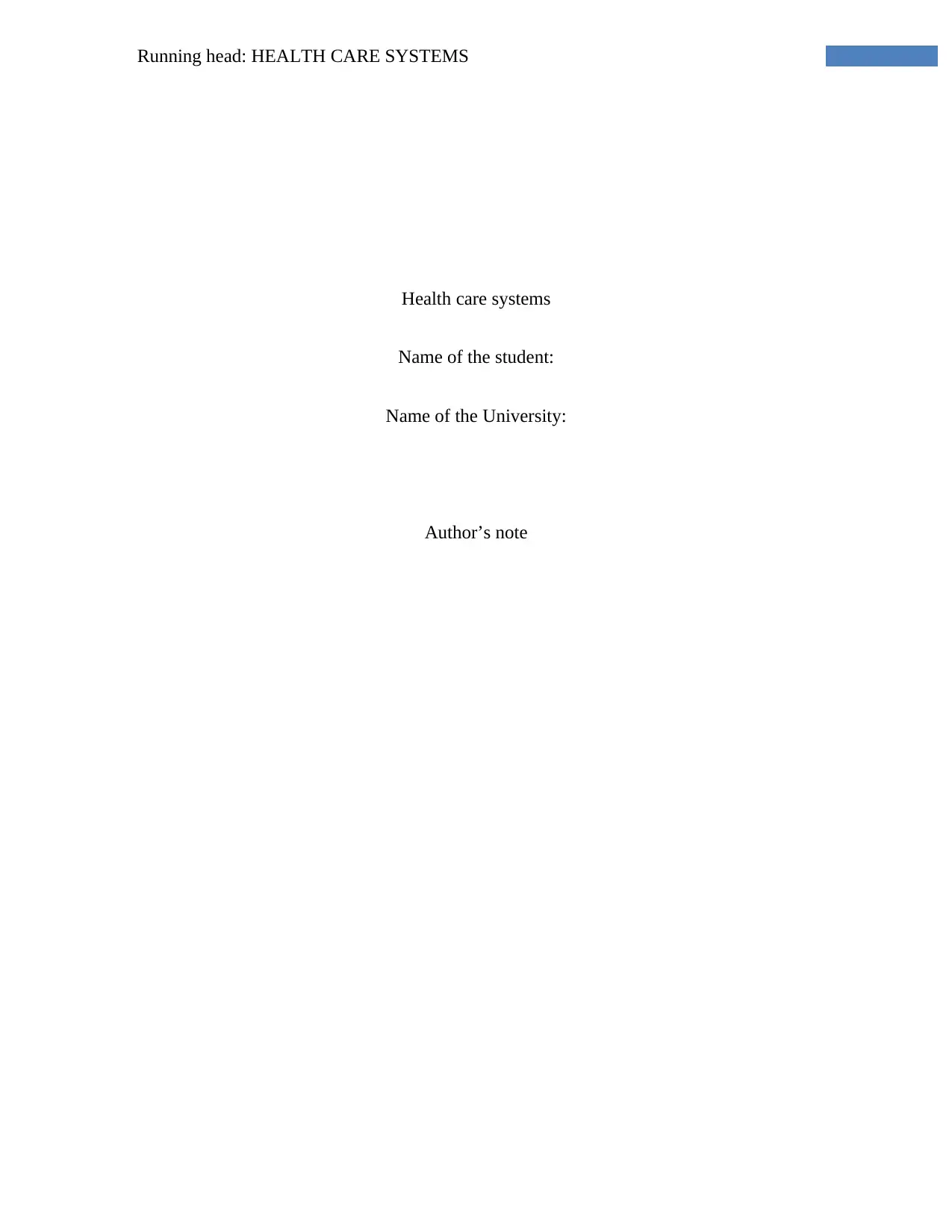
Running head: HEALTH CARE SYSTEMS
Health care systems
Name of the student:
Name of the University:
Author’s note
Health care systems
Name of the student:
Name of the University:
Author’s note
Paraphrase This Document
Need a fresh take? Get an instant paraphrase of this document with our AI Paraphraser
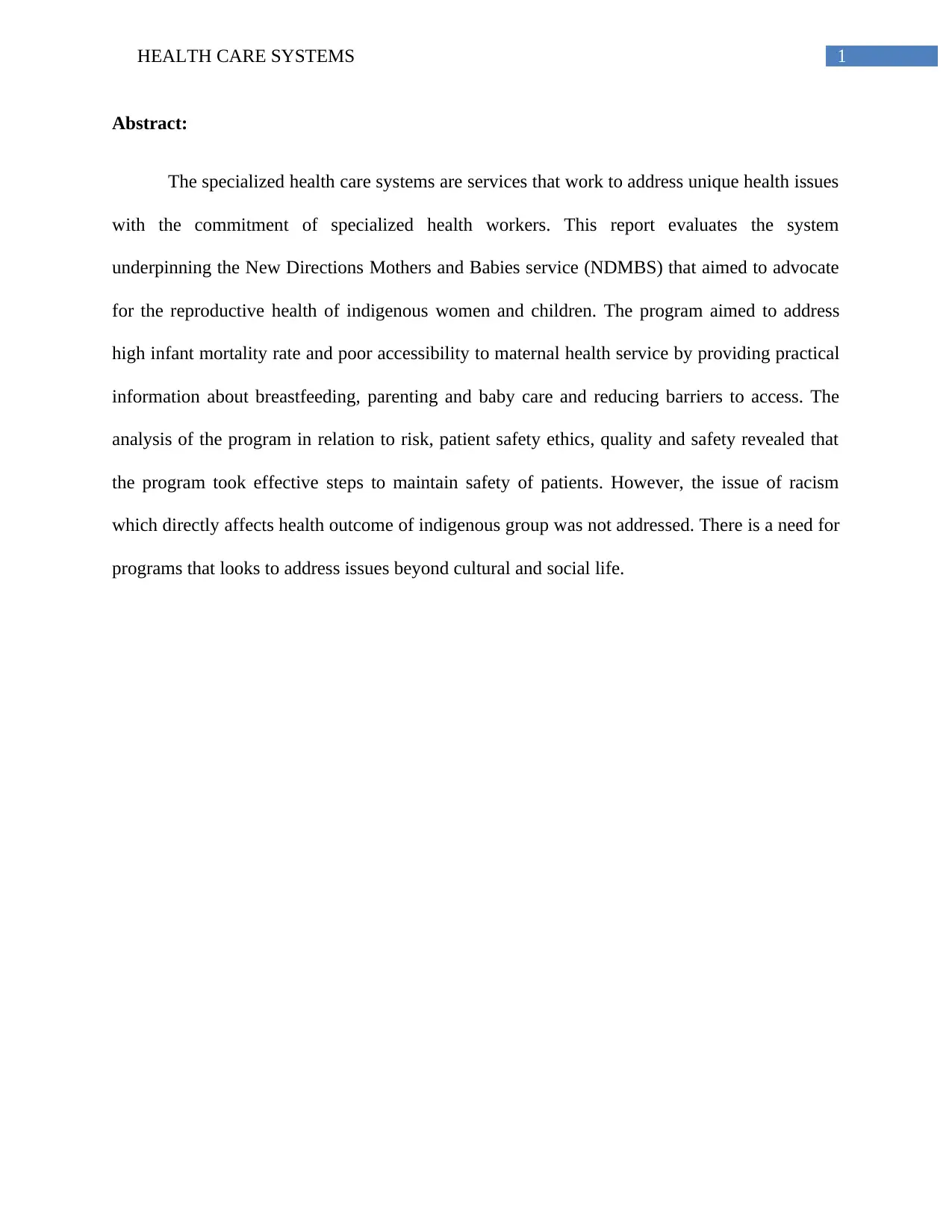
1HEALTH CARE SYSTEMS
Abstract:
The specialized health care systems are services that work to address unique health issues
with the commitment of specialized health workers. This report evaluates the system
underpinning the New Directions Mothers and Babies service (NDMBS) that aimed to advocate
for the reproductive health of indigenous women and children. The program aimed to address
high infant mortality rate and poor accessibility to maternal health service by providing practical
information about breastfeeding, parenting and baby care and reducing barriers to access. The
analysis of the program in relation to risk, patient safety ethics, quality and safety revealed that
the program took effective steps to maintain safety of patients. However, the issue of racism
which directly affects health outcome of indigenous group was not addressed. There is a need for
programs that looks to address issues beyond cultural and social life.
Abstract:
The specialized health care systems are services that work to address unique health issues
with the commitment of specialized health workers. This report evaluates the system
underpinning the New Directions Mothers and Babies service (NDMBS) that aimed to advocate
for the reproductive health of indigenous women and children. The program aimed to address
high infant mortality rate and poor accessibility to maternal health service by providing practical
information about breastfeeding, parenting and baby care and reducing barriers to access. The
analysis of the program in relation to risk, patient safety ethics, quality and safety revealed that
the program took effective steps to maintain safety of patients. However, the issue of racism
which directly affects health outcome of indigenous group was not addressed. There is a need for
programs that looks to address issues beyond cultural and social life.
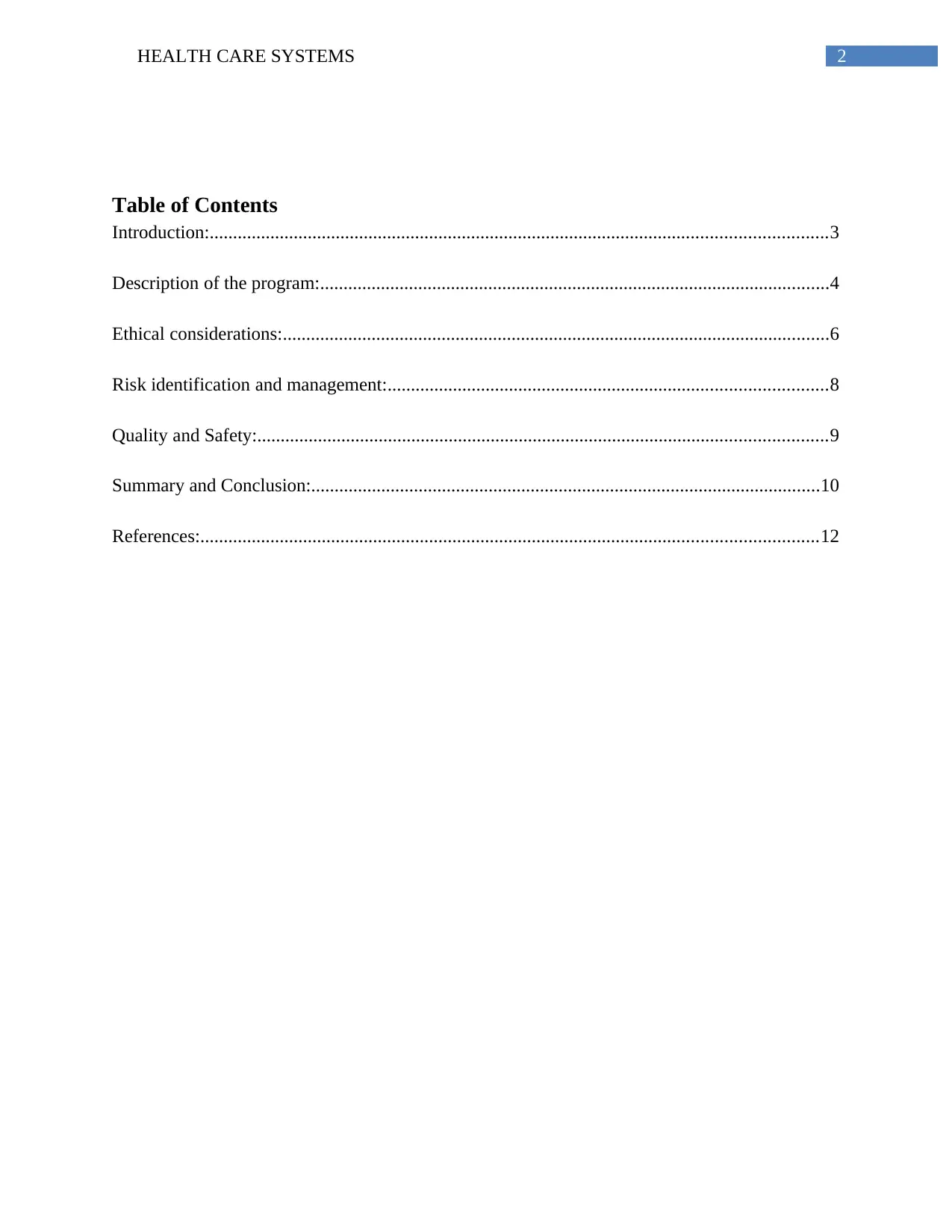
2HEALTH CARE SYSTEMS
Table of Contents
Introduction:....................................................................................................................................3
Description of the program:.............................................................................................................4
Ethical considerations:.....................................................................................................................6
Risk identification and management:..............................................................................................8
Quality and Safety:..........................................................................................................................9
Summary and Conclusion:.............................................................................................................10
References:....................................................................................................................................12
Table of Contents
Introduction:....................................................................................................................................3
Description of the program:.............................................................................................................4
Ethical considerations:.....................................................................................................................6
Risk identification and management:..............................................................................................8
Quality and Safety:..........................................................................................................................9
Summary and Conclusion:.............................................................................................................10
References:....................................................................................................................................12
⊘ This is a preview!⊘
Do you want full access?
Subscribe today to unlock all pages.

Trusted by 1+ million students worldwide
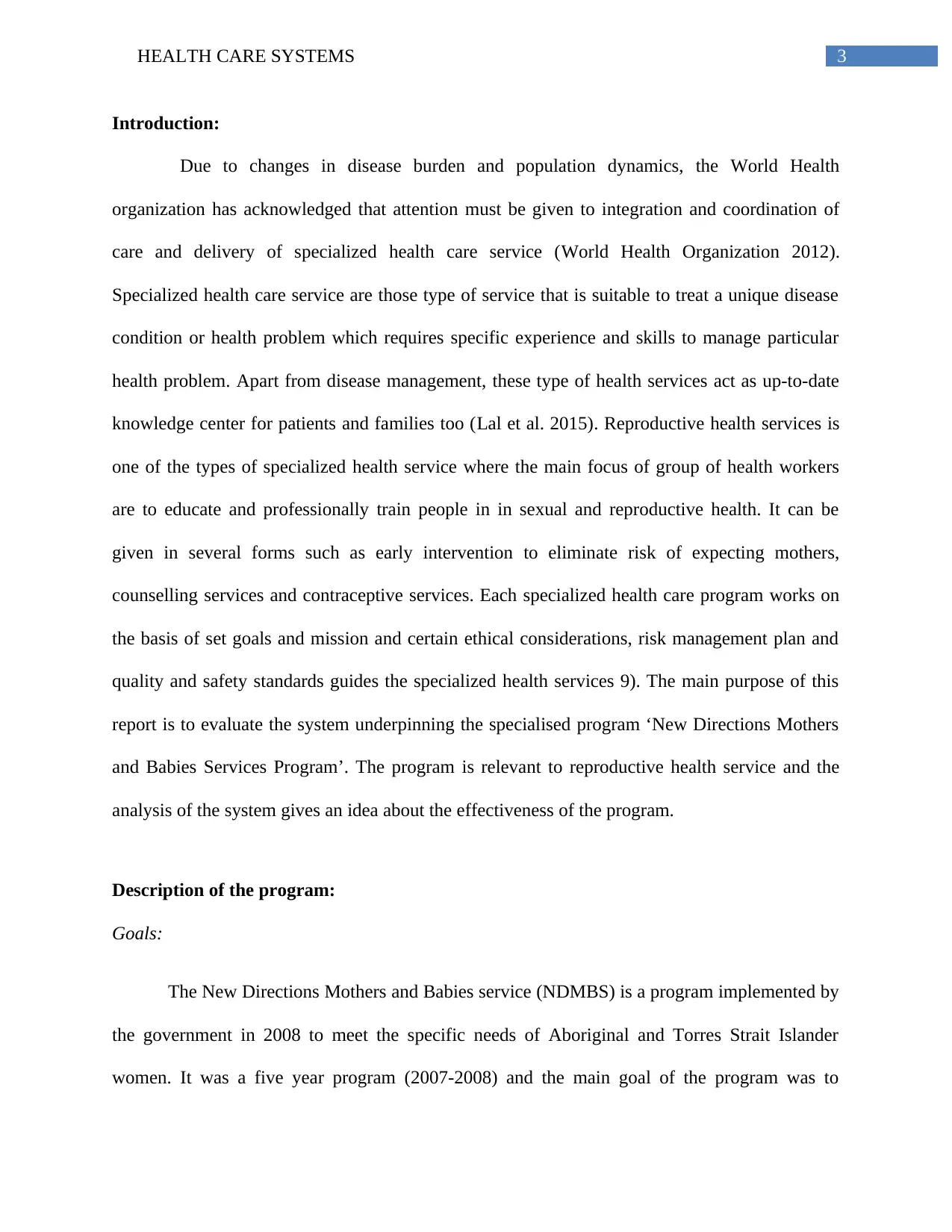
3HEALTH CARE SYSTEMS
Introduction:
Due to changes in disease burden and population dynamics, the World Health
organization has acknowledged that attention must be given to integration and coordination of
care and delivery of specialized health care service (World Health Organization 2012).
Specialized health care service are those type of service that is suitable to treat a unique disease
condition or health problem which requires specific experience and skills to manage particular
health problem. Apart from disease management, these type of health services act as up-to-date
knowledge center for patients and families too (Lal et al. 2015). Reproductive health services is
one of the types of specialized health service where the main focus of group of health workers
are to educate and professionally train people in in sexual and reproductive health. It can be
given in several forms such as early intervention to eliminate risk of expecting mothers,
counselling services and contraceptive services. Each specialized health care program works on
the basis of set goals and mission and certain ethical considerations, risk management plan and
quality and safety standards guides the specialized health services 9). The main purpose of this
report is to evaluate the system underpinning the specialised program ‘New Directions Mothers
and Babies Services Program’. The program is relevant to reproductive health service and the
analysis of the system gives an idea about the effectiveness of the program.
Description of the program:
Goals:
The New Directions Mothers and Babies service (NDMBS) is a program implemented by
the government in 2008 to meet the specific needs of Aboriginal and Torres Strait Islander
women. It was a five year program (2007-2008) and the main goal of the program was to
Introduction:
Due to changes in disease burden and population dynamics, the World Health
organization has acknowledged that attention must be given to integration and coordination of
care and delivery of specialized health care service (World Health Organization 2012).
Specialized health care service are those type of service that is suitable to treat a unique disease
condition or health problem which requires specific experience and skills to manage particular
health problem. Apart from disease management, these type of health services act as up-to-date
knowledge center for patients and families too (Lal et al. 2015). Reproductive health services is
one of the types of specialized health service where the main focus of group of health workers
are to educate and professionally train people in in sexual and reproductive health. It can be
given in several forms such as early intervention to eliminate risk of expecting mothers,
counselling services and contraceptive services. Each specialized health care program works on
the basis of set goals and mission and certain ethical considerations, risk management plan and
quality and safety standards guides the specialized health services 9). The main purpose of this
report is to evaluate the system underpinning the specialised program ‘New Directions Mothers
and Babies Services Program’. The program is relevant to reproductive health service and the
analysis of the system gives an idea about the effectiveness of the program.
Description of the program:
Goals:
The New Directions Mothers and Babies service (NDMBS) is a program implemented by
the government in 2008 to meet the specific needs of Aboriginal and Torres Strait Islander
women. It was a five year program (2007-2008) and the main goal of the program was to
Paraphrase This Document
Need a fresh take? Get an instant paraphrase of this document with our AI Paraphraser
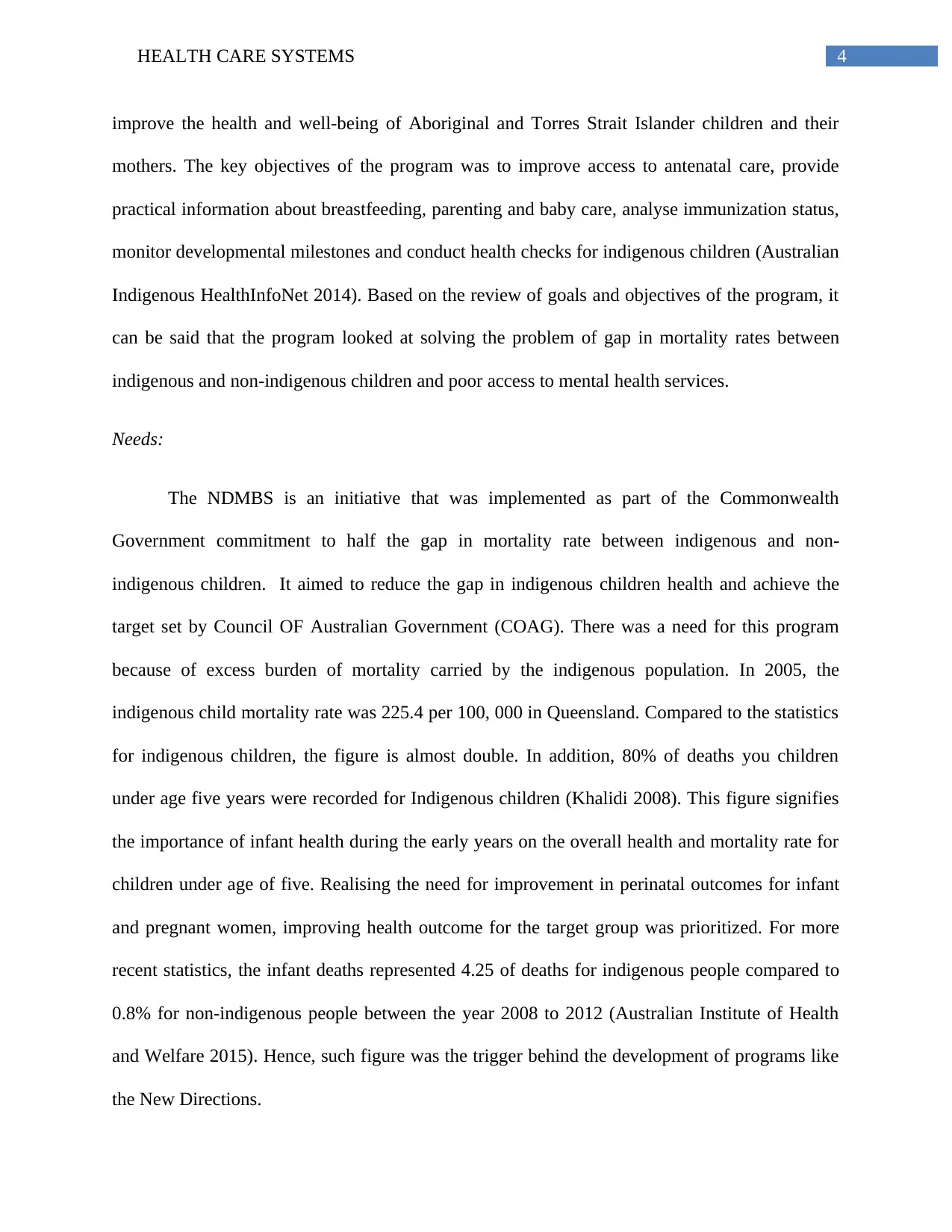
4HEALTH CARE SYSTEMS
improve the health and well-being of Aboriginal and Torres Strait Islander children and their
mothers. The key objectives of the program was to improve access to antenatal care, provide
practical information about breastfeeding, parenting and baby care, analyse immunization status,
monitor developmental milestones and conduct health checks for indigenous children (Australian
Indigenous HealthInfoNet 2014). Based on the review of goals and objectives of the program, it
can be said that the program looked at solving the problem of gap in mortality rates between
indigenous and non-indigenous children and poor access to mental health services.
Needs:
The NDMBS is an initiative that was implemented as part of the Commonwealth
Government commitment to half the gap in mortality rate between indigenous and non-
indigenous children. It aimed to reduce the gap in indigenous children health and achieve the
target set by Council OF Australian Government (COAG). There was a need for this program
because of excess burden of mortality carried by the indigenous population. In 2005, the
indigenous child mortality rate was 225.4 per 100, 000 in Queensland. Compared to the statistics
for indigenous children, the figure is almost double. In addition, 80% of deaths you children
under age five years were recorded for Indigenous children (Khalidi 2008). This figure signifies
the importance of infant health during the early years on the overall health and mortality rate for
children under age of five. Realising the need for improvement in perinatal outcomes for infant
and pregnant women, improving health outcome for the target group was prioritized. For more
recent statistics, the infant deaths represented 4.25 of deaths for indigenous people compared to
0.8% for non-indigenous people between the year 2008 to 2012 (Australian Institute of Health
and Welfare 2015). Hence, such figure was the trigger behind the development of programs like
the New Directions.
improve the health and well-being of Aboriginal and Torres Strait Islander children and their
mothers. The key objectives of the program was to improve access to antenatal care, provide
practical information about breastfeeding, parenting and baby care, analyse immunization status,
monitor developmental milestones and conduct health checks for indigenous children (Australian
Indigenous HealthInfoNet 2014). Based on the review of goals and objectives of the program, it
can be said that the program looked at solving the problem of gap in mortality rates between
indigenous and non-indigenous children and poor access to mental health services.
Needs:
The NDMBS is an initiative that was implemented as part of the Commonwealth
Government commitment to half the gap in mortality rate between indigenous and non-
indigenous children. It aimed to reduce the gap in indigenous children health and achieve the
target set by Council OF Australian Government (COAG). There was a need for this program
because of excess burden of mortality carried by the indigenous population. In 2005, the
indigenous child mortality rate was 225.4 per 100, 000 in Queensland. Compared to the statistics
for indigenous children, the figure is almost double. In addition, 80% of deaths you children
under age five years were recorded for Indigenous children (Khalidi 2008). This figure signifies
the importance of infant health during the early years on the overall health and mortality rate for
children under age of five. Realising the need for improvement in perinatal outcomes for infant
and pregnant women, improving health outcome for the target group was prioritized. For more
recent statistics, the infant deaths represented 4.25 of deaths for indigenous people compared to
0.8% for non-indigenous people between the year 2008 to 2012 (Australian Institute of Health
and Welfare 2015). Hence, such figure was the trigger behind the development of programs like
the New Directions.
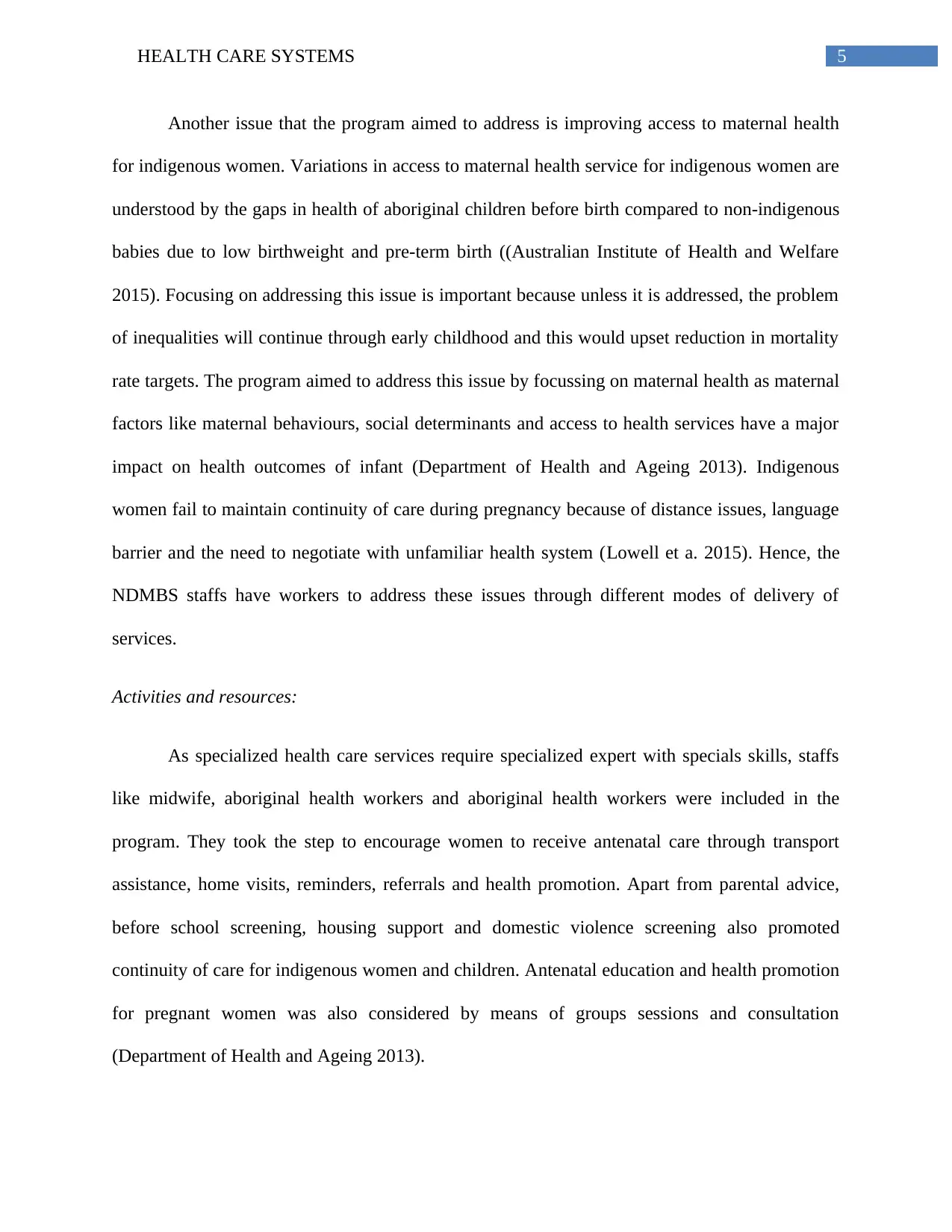
5HEALTH CARE SYSTEMS
Another issue that the program aimed to address is improving access to maternal health
for indigenous women. Variations in access to maternal health service for indigenous women are
understood by the gaps in health of aboriginal children before birth compared to non-indigenous
babies due to low birthweight and pre-term birth ((Australian Institute of Health and Welfare
2015). Focusing on addressing this issue is important because unless it is addressed, the problem
of inequalities will continue through early childhood and this would upset reduction in mortality
rate targets. The program aimed to address this issue by focussing on maternal health as maternal
factors like maternal behaviours, social determinants and access to health services have a major
impact on health outcomes of infant (Department of Health and Ageing 2013). Indigenous
women fail to maintain continuity of care during pregnancy because of distance issues, language
barrier and the need to negotiate with unfamiliar health system (Lowell et a. 2015). Hence, the
NDMBS staffs have workers to address these issues through different modes of delivery of
services.
Activities and resources:
As specialized health care services require specialized expert with specials skills, staffs
like midwife, aboriginal health workers and aboriginal health workers were included in the
program. They took the step to encourage women to receive antenatal care through transport
assistance, home visits, reminders, referrals and health promotion. Apart from parental advice,
before school screening, housing support and domestic violence screening also promoted
continuity of care for indigenous women and children. Antenatal education and health promotion
for pregnant women was also considered by means of groups sessions and consultation
(Department of Health and Ageing 2013).
Another issue that the program aimed to address is improving access to maternal health
for indigenous women. Variations in access to maternal health service for indigenous women are
understood by the gaps in health of aboriginal children before birth compared to non-indigenous
babies due to low birthweight and pre-term birth ((Australian Institute of Health and Welfare
2015). Focusing on addressing this issue is important because unless it is addressed, the problem
of inequalities will continue through early childhood and this would upset reduction in mortality
rate targets. The program aimed to address this issue by focussing on maternal health as maternal
factors like maternal behaviours, social determinants and access to health services have a major
impact on health outcomes of infant (Department of Health and Ageing 2013). Indigenous
women fail to maintain continuity of care during pregnancy because of distance issues, language
barrier and the need to negotiate with unfamiliar health system (Lowell et a. 2015). Hence, the
NDMBS staffs have workers to address these issues through different modes of delivery of
services.
Activities and resources:
As specialized health care services require specialized expert with specials skills, staffs
like midwife, aboriginal health workers and aboriginal health workers were included in the
program. They took the step to encourage women to receive antenatal care through transport
assistance, home visits, reminders, referrals and health promotion. Apart from parental advice,
before school screening, housing support and domestic violence screening also promoted
continuity of care for indigenous women and children. Antenatal education and health promotion
for pregnant women was also considered by means of groups sessions and consultation
(Department of Health and Ageing 2013).
⊘ This is a preview!⊘
Do you want full access?
Subscribe today to unlock all pages.

Trusted by 1+ million students worldwide
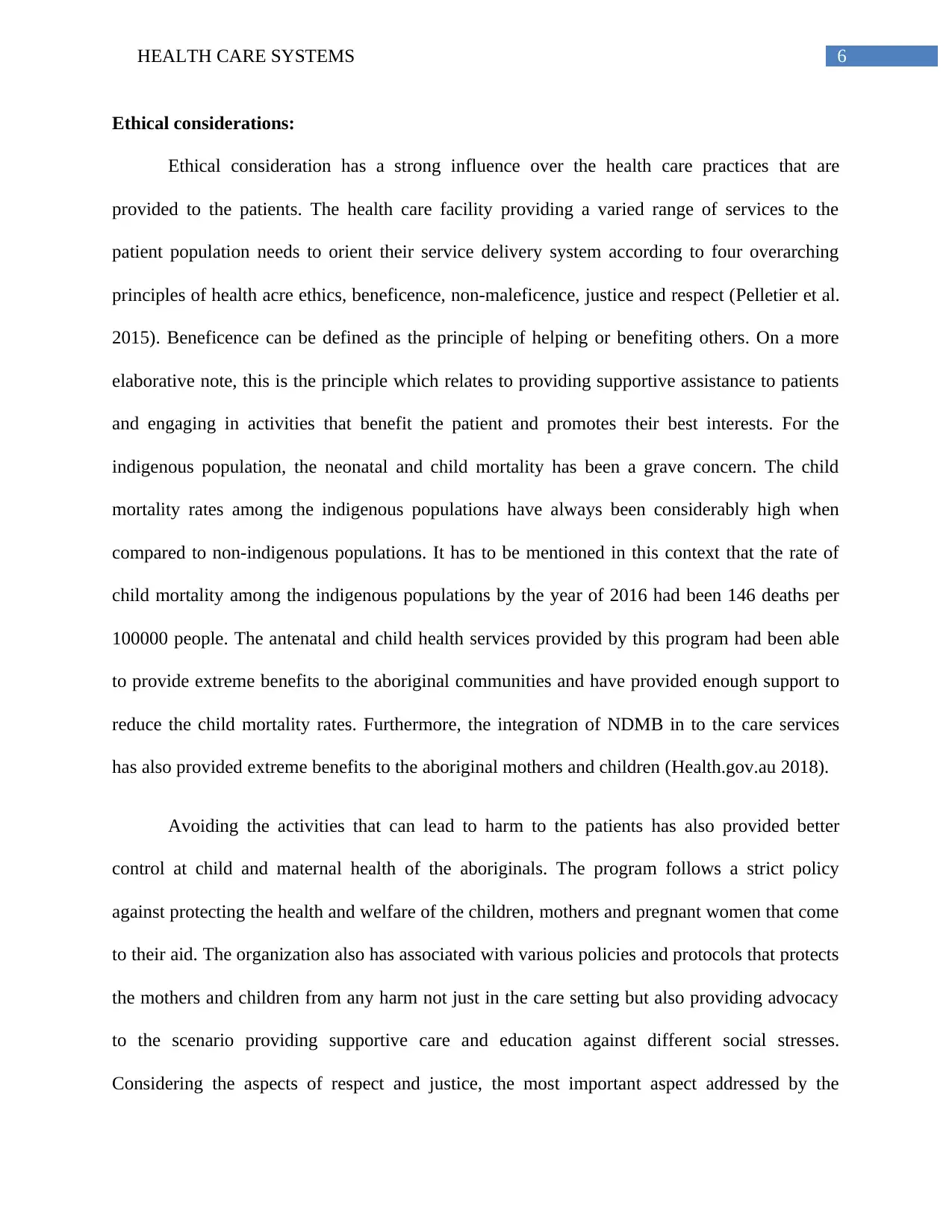
6HEALTH CARE SYSTEMS
Ethical considerations:
Ethical consideration has a strong influence over the health care practices that are
provided to the patients. The health care facility providing a varied range of services to the
patient population needs to orient their service delivery system according to four overarching
principles of health acre ethics, beneficence, non-maleficence, justice and respect (Pelletier et al.
2015). Beneficence can be defined as the principle of helping or benefiting others. On a more
elaborative note, this is the principle which relates to providing supportive assistance to patients
and engaging in activities that benefit the patient and promotes their best interests. For the
indigenous population, the neonatal and child mortality has been a grave concern. The child
mortality rates among the indigenous populations have always been considerably high when
compared to non-indigenous populations. It has to be mentioned in this context that the rate of
child mortality among the indigenous populations by the year of 2016 had been 146 deaths per
100000 people. The antenatal and child health services provided by this program had been able
to provide extreme benefits to the aboriginal communities and have provided enough support to
reduce the child mortality rates. Furthermore, the integration of NDMB in to the care services
has also provided extreme benefits to the aboriginal mothers and children (Health.gov.au 2018).
Avoiding the activities that can lead to harm to the patients has also provided better
control at child and maternal health of the aboriginals. The program follows a strict policy
against protecting the health and welfare of the children, mothers and pregnant women that come
to their aid. The organization also has associated with various policies and protocols that protects
the mothers and children from any harm not just in the care setting but also providing advocacy
to the scenario providing supportive care and education against different social stresses.
Considering the aspects of respect and justice, the most important aspect addressed by the
Ethical considerations:
Ethical consideration has a strong influence over the health care practices that are
provided to the patients. The health care facility providing a varied range of services to the
patient population needs to orient their service delivery system according to four overarching
principles of health acre ethics, beneficence, non-maleficence, justice and respect (Pelletier et al.
2015). Beneficence can be defined as the principle of helping or benefiting others. On a more
elaborative note, this is the principle which relates to providing supportive assistance to patients
and engaging in activities that benefit the patient and promotes their best interests. For the
indigenous population, the neonatal and child mortality has been a grave concern. The child
mortality rates among the indigenous populations have always been considerably high when
compared to non-indigenous populations. It has to be mentioned in this context that the rate of
child mortality among the indigenous populations by the year of 2016 had been 146 deaths per
100000 people. The antenatal and child health services provided by this program had been able
to provide extreme benefits to the aboriginal communities and have provided enough support to
reduce the child mortality rates. Furthermore, the integration of NDMB in to the care services
has also provided extreme benefits to the aboriginal mothers and children (Health.gov.au 2018).
Avoiding the activities that can lead to harm to the patients has also provided better
control at child and maternal health of the aboriginals. The program follows a strict policy
against protecting the health and welfare of the children, mothers and pregnant women that come
to their aid. The organization also has associated with various policies and protocols that protects
the mothers and children from any harm not just in the care setting but also providing advocacy
to the scenario providing supportive care and education against different social stresses.
Considering the aspects of respect and justice, the most important aspect addressed by the
Paraphrase This Document
Need a fresh take? Get an instant paraphrase of this document with our AI Paraphraser
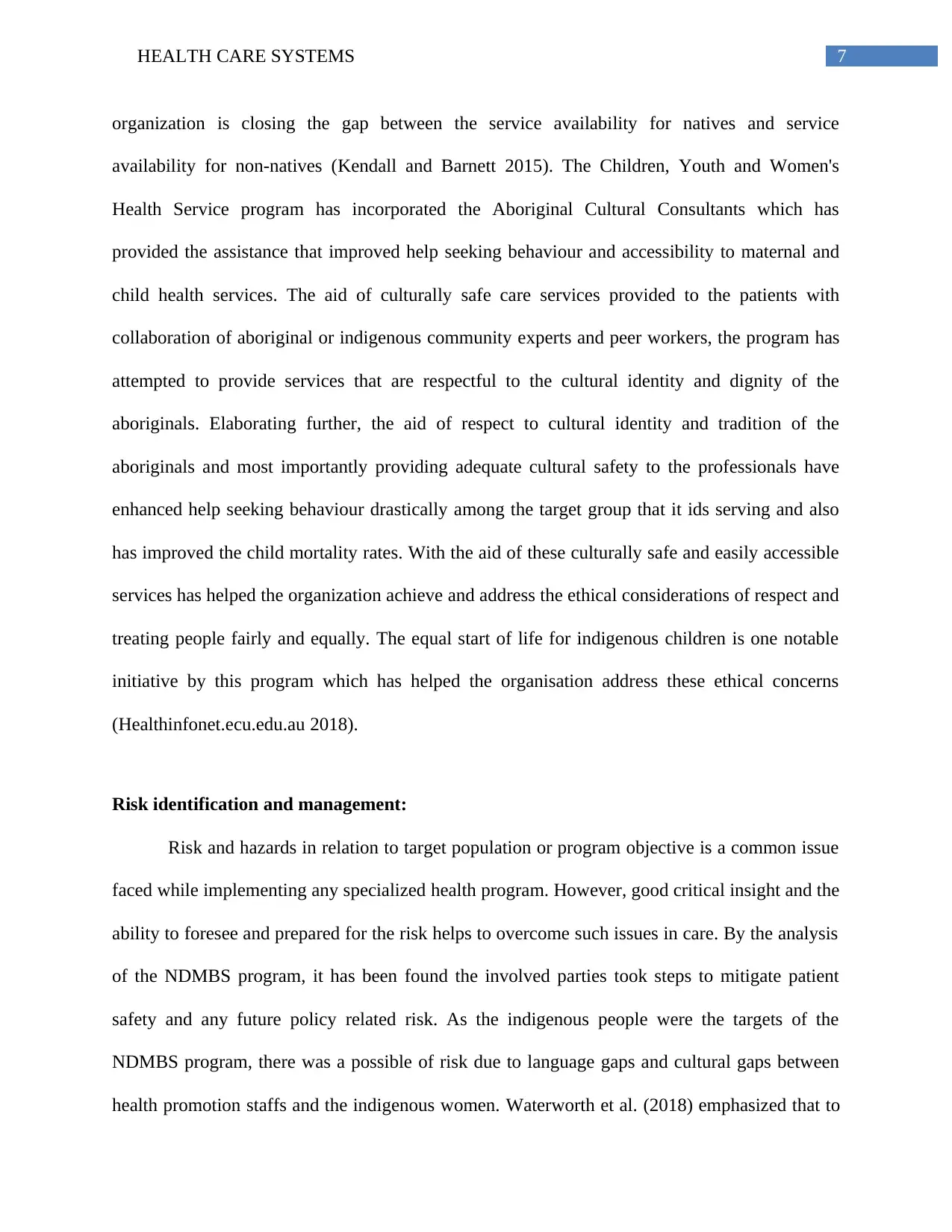
7HEALTH CARE SYSTEMS
organization is closing the gap between the service availability for natives and service
availability for non-natives (Kendall and Barnett 2015). The Children, Youth and Women's
Health Service program has incorporated the Aboriginal Cultural Consultants which has
provided the assistance that improved help seeking behaviour and accessibility to maternal and
child health services. The aid of culturally safe care services provided to the patients with
collaboration of aboriginal or indigenous community experts and peer workers, the program has
attempted to provide services that are respectful to the cultural identity and dignity of the
aboriginals. Elaborating further, the aid of respect to cultural identity and tradition of the
aboriginals and most importantly providing adequate cultural safety to the professionals have
enhanced help seeking behaviour drastically among the target group that it ids serving and also
has improved the child mortality rates. With the aid of these culturally safe and easily accessible
services has helped the organization achieve and address the ethical considerations of respect and
treating people fairly and equally. The equal start of life for indigenous children is one notable
initiative by this program which has helped the organisation address these ethical concerns
(Healthinfonet.ecu.edu.au 2018).
Risk identification and management:
Risk and hazards in relation to target population or program objective is a common issue
faced while implementing any specialized health program. However, good critical insight and the
ability to foresee and prepared for the risk helps to overcome such issues in care. By the analysis
of the NDMBS program, it has been found the involved parties took steps to mitigate patient
safety and any future policy related risk. As the indigenous people were the targets of the
NDMBS program, there was a possible of risk due to language gaps and cultural gaps between
health promotion staffs and the indigenous women. Waterworth et al. (2018) emphasized that to
organization is closing the gap between the service availability for natives and service
availability for non-natives (Kendall and Barnett 2015). The Children, Youth and Women's
Health Service program has incorporated the Aboriginal Cultural Consultants which has
provided the assistance that improved help seeking behaviour and accessibility to maternal and
child health services. The aid of culturally safe care services provided to the patients with
collaboration of aboriginal or indigenous community experts and peer workers, the program has
attempted to provide services that are respectful to the cultural identity and dignity of the
aboriginals. Elaborating further, the aid of respect to cultural identity and tradition of the
aboriginals and most importantly providing adequate cultural safety to the professionals have
enhanced help seeking behaviour drastically among the target group that it ids serving and also
has improved the child mortality rates. With the aid of these culturally safe and easily accessible
services has helped the organization achieve and address the ethical considerations of respect and
treating people fairly and equally. The equal start of life for indigenous children is one notable
initiative by this program which has helped the organisation address these ethical concerns
(Healthinfonet.ecu.edu.au 2018).
Risk identification and management:
Risk and hazards in relation to target population or program objective is a common issue
faced while implementing any specialized health program. However, good critical insight and the
ability to foresee and prepared for the risk helps to overcome such issues in care. By the analysis
of the NDMBS program, it has been found the involved parties took steps to mitigate patient
safety and any future policy related risk. As the indigenous people were the targets of the
NDMBS program, there was a possible of risk due to language gaps and cultural gaps between
health promotion staffs and the indigenous women. Waterworth et al. (2018) emphasized that to
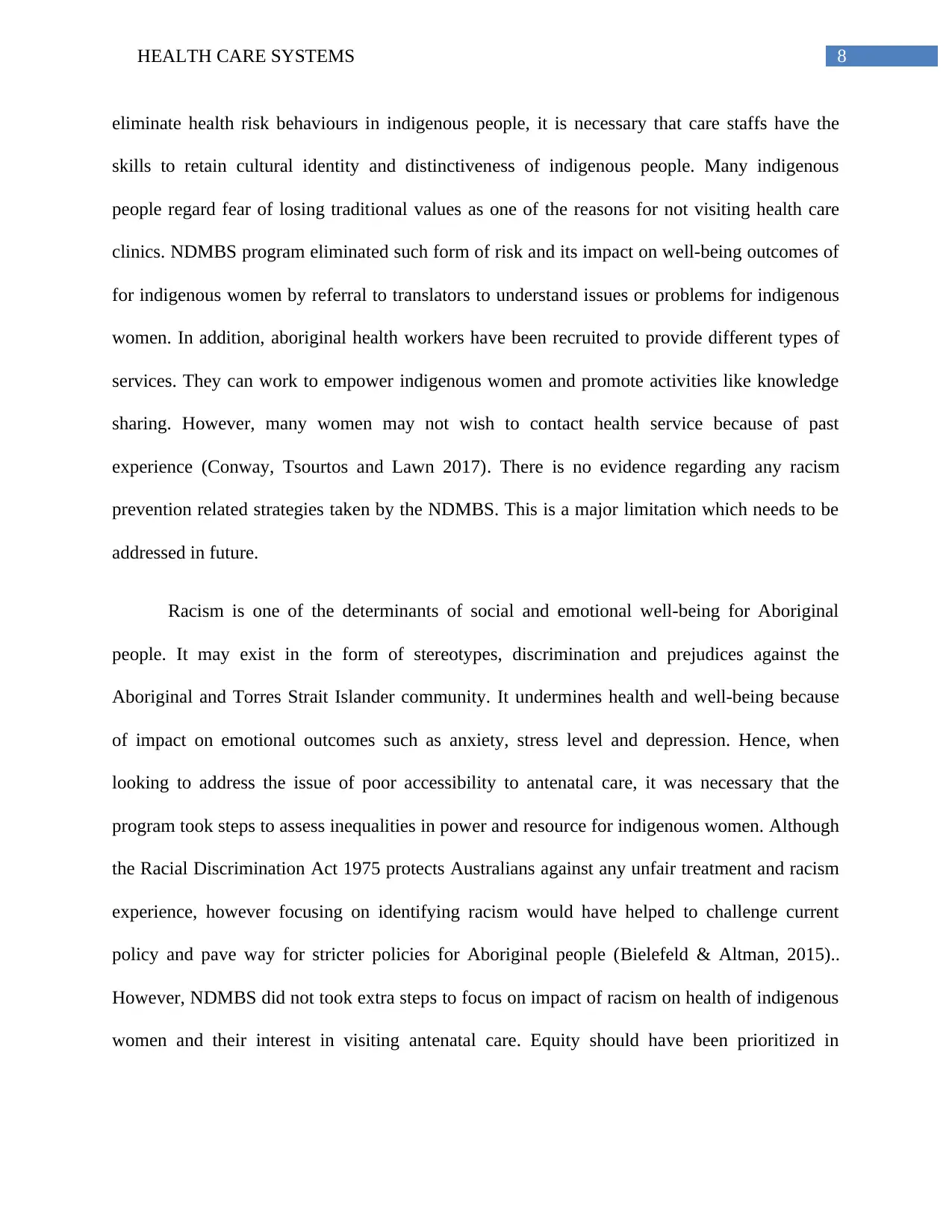
8HEALTH CARE SYSTEMS
eliminate health risk behaviours in indigenous people, it is necessary that care staffs have the
skills to retain cultural identity and distinctiveness of indigenous people. Many indigenous
people regard fear of losing traditional values as one of the reasons for not visiting health care
clinics. NDMBS program eliminated such form of risk and its impact on well-being outcomes of
for indigenous women by referral to translators to understand issues or problems for indigenous
women. In addition, aboriginal health workers have been recruited to provide different types of
services. They can work to empower indigenous women and promote activities like knowledge
sharing. However, many women may not wish to contact health service because of past
experience (Conway, Tsourtos and Lawn 2017). There is no evidence regarding any racism
prevention related strategies taken by the NDMBS. This is a major limitation which needs to be
addressed in future.
Racism is one of the determinants of social and emotional well-being for Aboriginal
people. It may exist in the form of stereotypes, discrimination and prejudices against the
Aboriginal and Torres Strait Islander community. It undermines health and well-being because
of impact on emotional outcomes such as anxiety, stress level and depression. Hence, when
looking to address the issue of poor accessibility to antenatal care, it was necessary that the
program took steps to assess inequalities in power and resource for indigenous women. Although
the Racial Discrimination Act 1975 protects Australians against any unfair treatment and racism
experience, however focusing on identifying racism would have helped to challenge current
policy and pave way for stricter policies for Aboriginal people (Bielefeld & Altman, 2015)..
However, NDMBS did not took extra steps to focus on impact of racism on health of indigenous
women and their interest in visiting antenatal care. Equity should have been prioritized in
eliminate health risk behaviours in indigenous people, it is necessary that care staffs have the
skills to retain cultural identity and distinctiveness of indigenous people. Many indigenous
people regard fear of losing traditional values as one of the reasons for not visiting health care
clinics. NDMBS program eliminated such form of risk and its impact on well-being outcomes of
for indigenous women by referral to translators to understand issues or problems for indigenous
women. In addition, aboriginal health workers have been recruited to provide different types of
services. They can work to empower indigenous women and promote activities like knowledge
sharing. However, many women may not wish to contact health service because of past
experience (Conway, Tsourtos and Lawn 2017). There is no evidence regarding any racism
prevention related strategies taken by the NDMBS. This is a major limitation which needs to be
addressed in future.
Racism is one of the determinants of social and emotional well-being for Aboriginal
people. It may exist in the form of stereotypes, discrimination and prejudices against the
Aboriginal and Torres Strait Islander community. It undermines health and well-being because
of impact on emotional outcomes such as anxiety, stress level and depression. Hence, when
looking to address the issue of poor accessibility to antenatal care, it was necessary that the
program took steps to assess inequalities in power and resource for indigenous women. Although
the Racial Discrimination Act 1975 protects Australians against any unfair treatment and racism
experience, however focusing on identifying racism would have helped to challenge current
policy and pave way for stricter policies for Aboriginal people (Bielefeld & Altman, 2015)..
However, NDMBS did not took extra steps to focus on impact of racism on health of indigenous
women and their interest in visiting antenatal care. Equity should have been prioritized in
⊘ This is a preview!⊘
Do you want full access?
Subscribe today to unlock all pages.

Trusted by 1+ million students worldwide
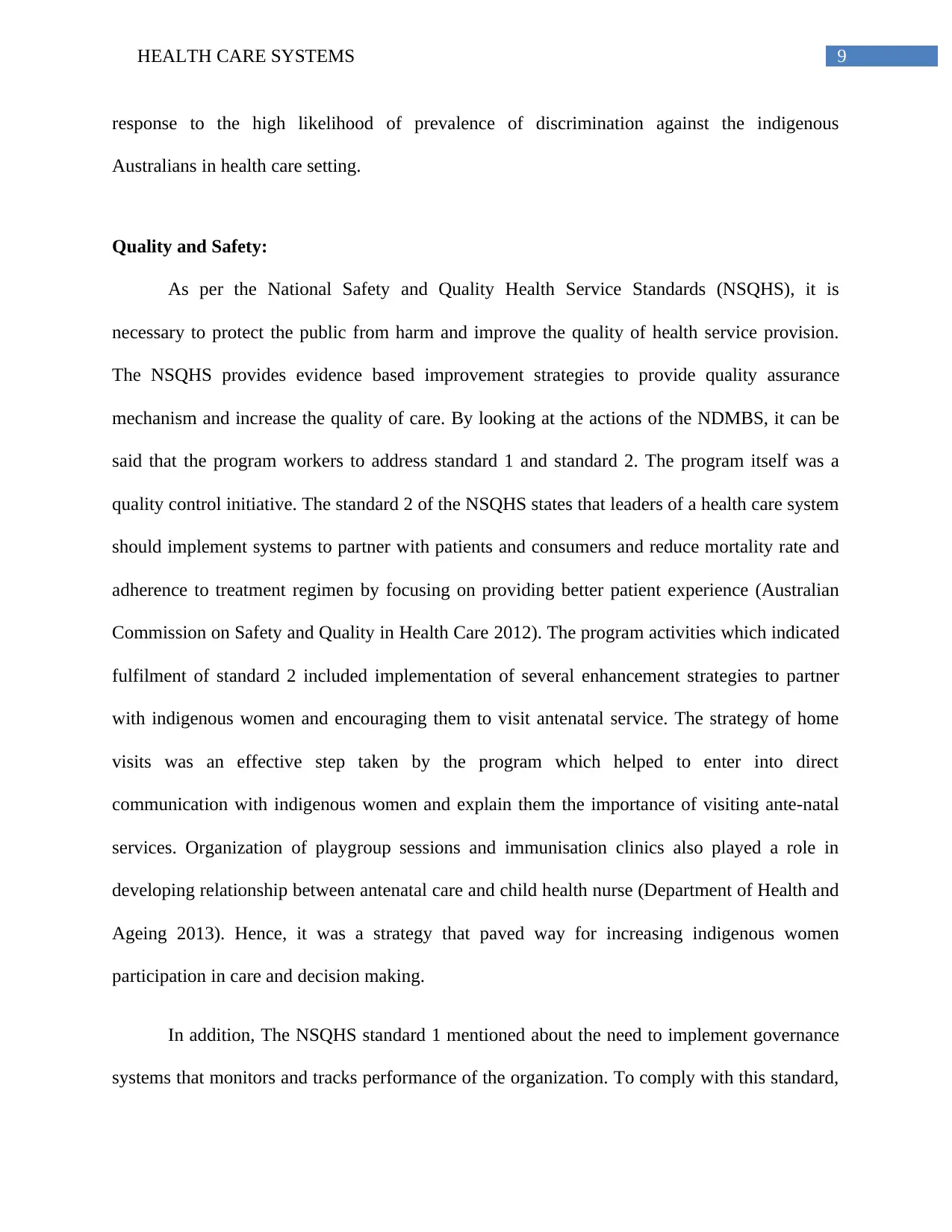
9HEALTH CARE SYSTEMS
response to the high likelihood of prevalence of discrimination against the indigenous
Australians in health care setting.
Quality and Safety:
As per the National Safety and Quality Health Service Standards (NSQHS), it is
necessary to protect the public from harm and improve the quality of health service provision.
The NSQHS provides evidence based improvement strategies to provide quality assurance
mechanism and increase the quality of care. By looking at the actions of the NDMBS, it can be
said that the program workers to address standard 1 and standard 2. The program itself was a
quality control initiative. The standard 2 of the NSQHS states that leaders of a health care system
should implement systems to partner with patients and consumers and reduce mortality rate and
adherence to treatment regimen by focusing on providing better patient experience (Australian
Commission on Safety and Quality in Health Care 2012). The program activities which indicated
fulfilment of standard 2 included implementation of several enhancement strategies to partner
with indigenous women and encouraging them to visit antenatal service. The strategy of home
visits was an effective step taken by the program which helped to enter into direct
communication with indigenous women and explain them the importance of visiting ante-natal
services. Organization of playgroup sessions and immunisation clinics also played a role in
developing relationship between antenatal care and child health nurse (Department of Health and
Ageing 2013). Hence, it was a strategy that paved way for increasing indigenous women
participation in care and decision making.
In addition, The NSQHS standard 1 mentioned about the need to implement governance
systems that monitors and tracks performance of the organization. To comply with this standard,
response to the high likelihood of prevalence of discrimination against the indigenous
Australians in health care setting.
Quality and Safety:
As per the National Safety and Quality Health Service Standards (NSQHS), it is
necessary to protect the public from harm and improve the quality of health service provision.
The NSQHS provides evidence based improvement strategies to provide quality assurance
mechanism and increase the quality of care. By looking at the actions of the NDMBS, it can be
said that the program workers to address standard 1 and standard 2. The program itself was a
quality control initiative. The standard 2 of the NSQHS states that leaders of a health care system
should implement systems to partner with patients and consumers and reduce mortality rate and
adherence to treatment regimen by focusing on providing better patient experience (Australian
Commission on Safety and Quality in Health Care 2012). The program activities which indicated
fulfilment of standard 2 included implementation of several enhancement strategies to partner
with indigenous women and encouraging them to visit antenatal service. The strategy of home
visits was an effective step taken by the program which helped to enter into direct
communication with indigenous women and explain them the importance of visiting ante-natal
services. Organization of playgroup sessions and immunisation clinics also played a role in
developing relationship between antenatal care and child health nurse (Department of Health and
Ageing 2013). Hence, it was a strategy that paved way for increasing indigenous women
participation in care and decision making.
In addition, The NSQHS standard 1 mentioned about the need to implement governance
systems that monitors and tracks performance of the organization. To comply with this standard,
Paraphrase This Document
Need a fresh take? Get an instant paraphrase of this document with our AI Paraphraser
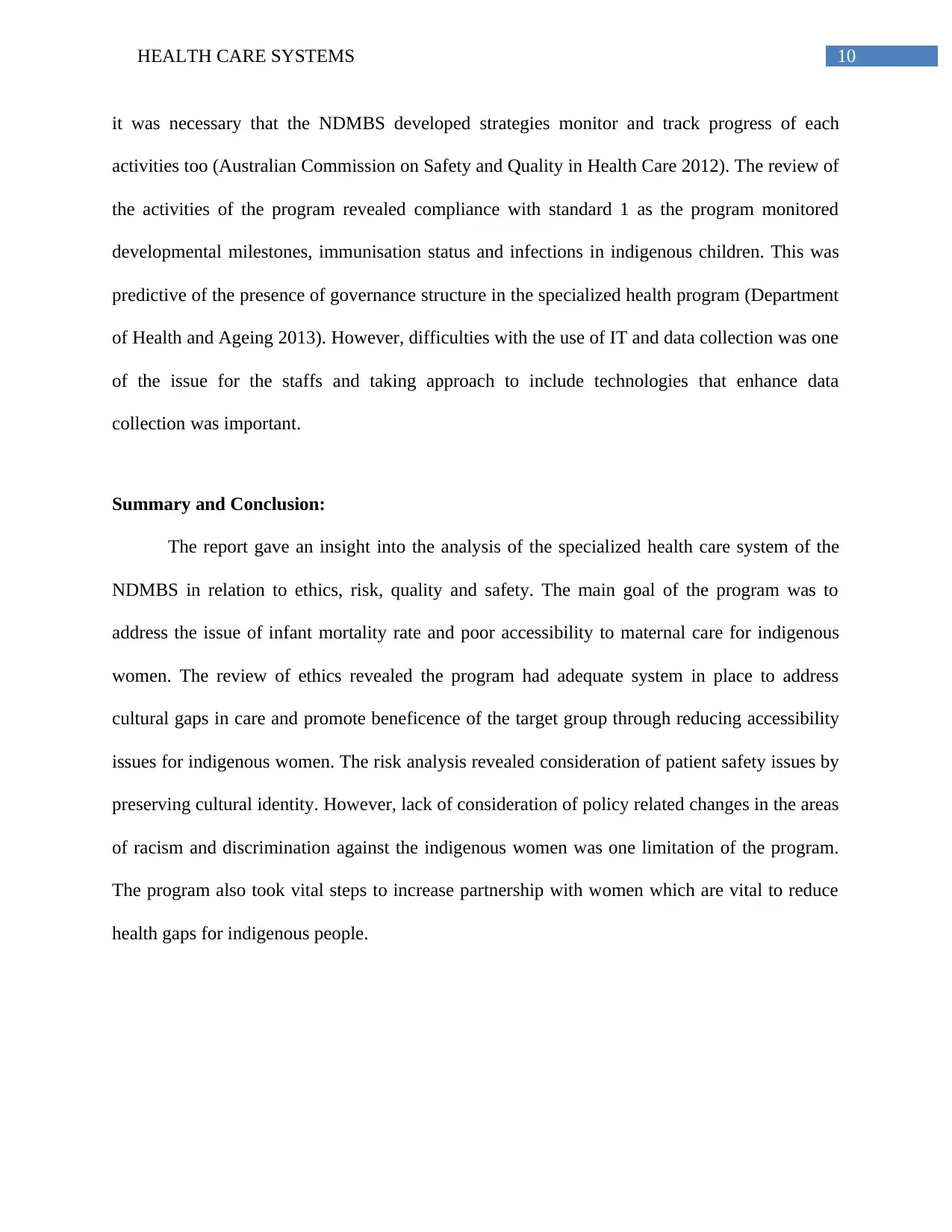
10HEALTH CARE SYSTEMS
it was necessary that the NDMBS developed strategies monitor and track progress of each
activities too (Australian Commission on Safety and Quality in Health Care 2012). The review of
the activities of the program revealed compliance with standard 1 as the program monitored
developmental milestones, immunisation status and infections in indigenous children. This was
predictive of the presence of governance structure in the specialized health program (Department
of Health and Ageing 2013). However, difficulties with the use of IT and data collection was one
of the issue for the staffs and taking approach to include technologies that enhance data
collection was important.
Summary and Conclusion:
The report gave an insight into the analysis of the specialized health care system of the
NDMBS in relation to ethics, risk, quality and safety. The main goal of the program was to
address the issue of infant mortality rate and poor accessibility to maternal care for indigenous
women. The review of ethics revealed the program had adequate system in place to address
cultural gaps in care and promote beneficence of the target group through reducing accessibility
issues for indigenous women. The risk analysis revealed consideration of patient safety issues by
preserving cultural identity. However, lack of consideration of policy related changes in the areas
of racism and discrimination against the indigenous women was one limitation of the program.
The program also took vital steps to increase partnership with women which are vital to reduce
health gaps for indigenous people.
it was necessary that the NDMBS developed strategies monitor and track progress of each
activities too (Australian Commission on Safety and Quality in Health Care 2012). The review of
the activities of the program revealed compliance with standard 1 as the program monitored
developmental milestones, immunisation status and infections in indigenous children. This was
predictive of the presence of governance structure in the specialized health program (Department
of Health and Ageing 2013). However, difficulties with the use of IT and data collection was one
of the issue for the staffs and taking approach to include technologies that enhance data
collection was important.
Summary and Conclusion:
The report gave an insight into the analysis of the specialized health care system of the
NDMBS in relation to ethics, risk, quality and safety. The main goal of the program was to
address the issue of infant mortality rate and poor accessibility to maternal care for indigenous
women. The review of ethics revealed the program had adequate system in place to address
cultural gaps in care and promote beneficence of the target group through reducing accessibility
issues for indigenous women. The risk analysis revealed consideration of patient safety issues by
preserving cultural identity. However, lack of consideration of policy related changes in the areas
of racism and discrimination against the indigenous women was one limitation of the program.
The program also took vital steps to increase partnership with women which are vital to reduce
health gaps for indigenous people.
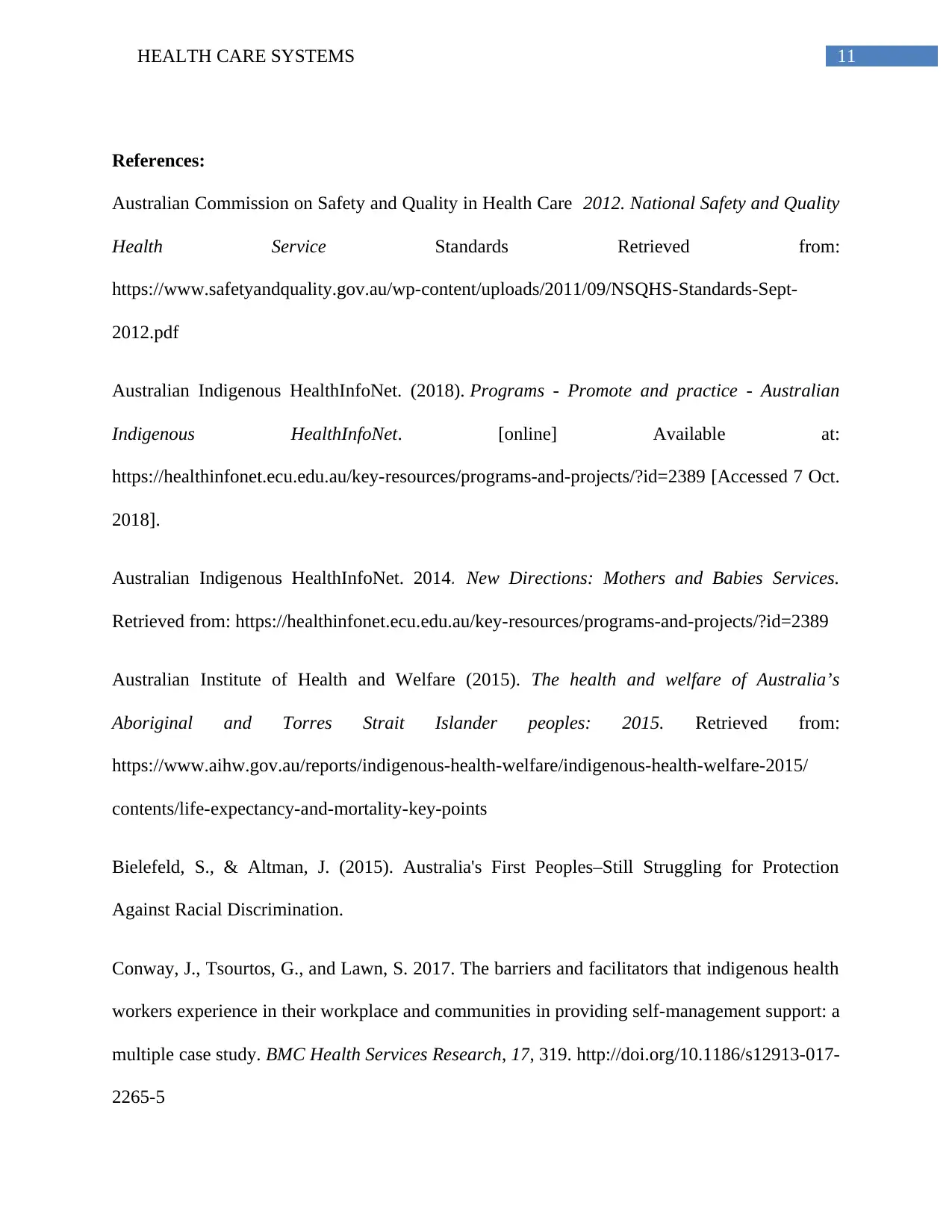
11HEALTH CARE SYSTEMS
References:
Australian Commission on Safety and Quality in Health Care 2012. National Safety and Quality
Health Service Standards Retrieved from:
https://www.safetyandquality.gov.au/wp-content/uploads/2011/09/NSQHS-Standards-Sept-
2012.pdf
Australian Indigenous HealthInfoNet. (2018). Programs - Promote and practice - Australian
Indigenous HealthInfoNet. [online] Available at:
https://healthinfonet.ecu.edu.au/key-resources/programs-and-projects/?id=2389 [Accessed 7 Oct.
2018].
Australian Indigenous HealthInfoNet. 2014. New Directions: Mothers and Babies Services.
Retrieved from: https://healthinfonet.ecu.edu.au/key-resources/programs-and-projects/?id=2389
Australian Institute of Health and Welfare (2015). The health and welfare of Australia’s
Aboriginal and Torres Strait Islander peoples: 2015. Retrieved from:
https://www.aihw.gov.au/reports/indigenous-health-welfare/indigenous-health-welfare-2015/
contents/life-expectancy-and-mortality-key-points
Bielefeld, S., & Altman, J. (2015). Australia's First Peoples–Still Struggling for Protection
Against Racial Discrimination.
Conway, J., Tsourtos, G., and Lawn, S. 2017. The barriers and facilitators that indigenous health
workers experience in their workplace and communities in providing self-management support: a
multiple case study. BMC Health Services Research, 17, 319. http://doi.org/10.1186/s12913-017-
2265-5
References:
Australian Commission on Safety and Quality in Health Care 2012. National Safety and Quality
Health Service Standards Retrieved from:
https://www.safetyandquality.gov.au/wp-content/uploads/2011/09/NSQHS-Standards-Sept-
2012.pdf
Australian Indigenous HealthInfoNet. (2018). Programs - Promote and practice - Australian
Indigenous HealthInfoNet. [online] Available at:
https://healthinfonet.ecu.edu.au/key-resources/programs-and-projects/?id=2389 [Accessed 7 Oct.
2018].
Australian Indigenous HealthInfoNet. 2014. New Directions: Mothers and Babies Services.
Retrieved from: https://healthinfonet.ecu.edu.au/key-resources/programs-and-projects/?id=2389
Australian Institute of Health and Welfare (2015). The health and welfare of Australia’s
Aboriginal and Torres Strait Islander peoples: 2015. Retrieved from:
https://www.aihw.gov.au/reports/indigenous-health-welfare/indigenous-health-welfare-2015/
contents/life-expectancy-and-mortality-key-points
Bielefeld, S., & Altman, J. (2015). Australia's First Peoples–Still Struggling for Protection
Against Racial Discrimination.
Conway, J., Tsourtos, G., and Lawn, S. 2017. The barriers and facilitators that indigenous health
workers experience in their workplace and communities in providing self-management support: a
multiple case study. BMC Health Services Research, 17, 319. http://doi.org/10.1186/s12913-017-
2265-5
⊘ This is a preview!⊘
Do you want full access?
Subscribe today to unlock all pages.

Trusted by 1+ million students worldwide
1 out of 14
Related Documents
Your All-in-One AI-Powered Toolkit for Academic Success.
+13062052269
info@desklib.com
Available 24*7 on WhatsApp / Email
![[object Object]](/_next/static/media/star-bottom.7253800d.svg)
Unlock your academic potential
Copyright © 2020–2025 A2Z Services. All Rights Reserved. Developed and managed by ZUCOL.




